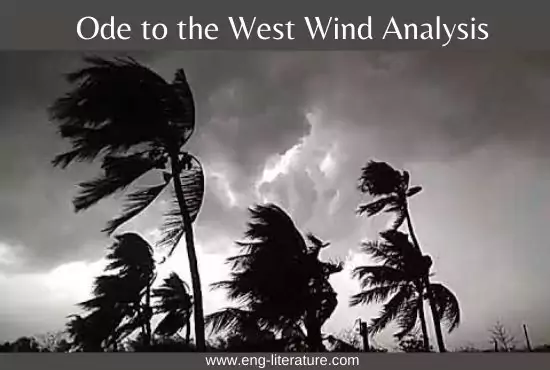Ode to the West Wind Analysis
Ode to the West Wind is the most impressive and the most rapturous of Shelley’s poems. In it, as in Prometheus Unbound, all his poetic powers and subjects are splendidly wrought into a whole.
“The emotion awakened by the approaching storm sets on fire other sleeping emotions in his heart and the whole of his being bursts into flame around the first emotion.” (S. Brooke)
The theme is developed to its climax logically and with that sweep of imagination which scales the earth, the heaven and the mind of man. The poet describes the activities of the West Wind on the land, in the sky and on the sea. Next, he describes himself as a wretched creature—a man shorn of youthful energy and vitality and bleeding on the thorns of life. Then he mingles the individual with the universal, himself with nature (the Wind) so that he may sing of the restoration of mankind.
“Ode to the West Wind combines with the highest degree of imaginative quality,” writes Herford, “the two other characteristic notes of Shelley’s lyrics-personal despondency and prophetic vision.” The violent energy and impetuosity of the West Wind pathetically reminds the poet of his weakness and the ills and evils of life he has suffered from. The tragedy of his life is too great for him to bear; so he cries:
“I fall upon the thorns of life! I bleed!
A heavy weight of hours has chained and bowed
One too like thee.”
The poem embodies his prophetic vision—his hope of a world delivered from evil. He prays the West Wind to help him to scatter his unrealized revolutionary ideas all over the world and create in men a change of heart so that a new regenerated world might be the future outcome. He is hopeful that when the winter of exploitation and oppression has come, the spring of happiness and freedom will not be long to follow:
“If Winter comes, can Spring be far behind?”
Ode to the West Wind is, as Prof. Oliver Elton says, “the greatest of all those lyrics of Shelley which do not, in brief compass, convey a single and simple emotion.” The first three stanzas follow the West Wind in its course; the fourth calls upon it to bear the poet away from the heavy weight of hour; and the last prays for the complete absorption of the poet in the West Wind, so that he may rekindle his dead song and scatter it among the hearts of men. But the emotions are inter-related and have been fused into an artistic whole. In lyrical intensity combined with lyrical breadth the Ode is unsurpassed in English song. S. A. Brooke calls it “the lyric of lyrics.”
Ode to the West Wind is remarkable for its imagery. Images come one after another in rapid succession. They are in most cases similes and metaphors— “dead leaves are driven like ghosts from an enchanter fleeing.” “Pestilence-stricken multitudes”, “Each like a corpse within its grave”, “Thou dirge of the dying year”, “If I were a dead leaf”, etc. They are mostly drawn from the world of death and decay. Some of them are intangible and imaginary, and they are employed to illustrate the actual and tangible (e.g. disorderly masses of clouds compared to the dishevelled hair on the head of Maenad, leaves compared to ghosts etc.).
Also Read:
Ode to the West Wind illustrates Shelley’s characteristic attitude towards nature. He often uses natural phenomena as emblematic of his mental state. The West Wind is for him the trumpet for a prophecy and an instrument by which his inseminating principles can be broadcasted. Shelley’s myth-making power is in evidence in the poem. He personifies the West Wind and represents it as a destroyer and preserver. It is a wild spirit operating everywhere on the earth, in the sky and over the ocean.
Artistically the poem scales the height of perfection. The verse sweeps along with the elemental rush of the wind it celebrates. Metaphor succeeds to metaphor and simile to simile with wild rapidity and there is none of the hazy indistinctness that mars Shelley’s less perfect works. The poem falls into five equal verses of chain-rhyme or terza rima, with an overture, a refrain and a climax – a scheme of his own making which fits in with the passion and feeling in the poem.

Hello, Viewers! Besides being the Founder and Owner of this website, I am a Government Officer. As a hardcore literary lover, I am pursuing my dream by writing notes and articles related to Literature. Drop me a line anytime, whether it’s about any queries or demands or just to share your well-being. I’d love to hear from you. Thanks for stopping by!

Thanks very helpful notes
Please share the analysis of ode to psyche and ode on melancholy
I’m very thankful to you for this
Sincerely welcome
Sir please share the analysis of ode to psyche and ode on melancholy
I’m very thankful to you for this